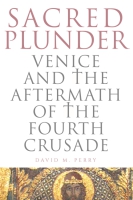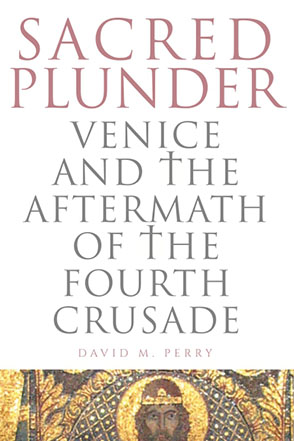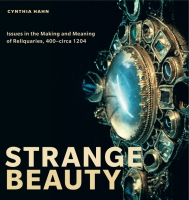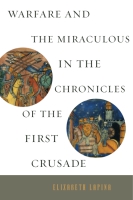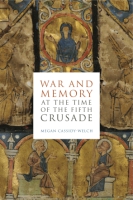Sacred Plunder
Venice and the Aftermath of the Fourth Crusade
David M. Perry
“This insightful work is the first to explore the effects that waves of displaced relics from Constantinople had on Venice and, more broadly, Latin Christianity. Peeling back layers of narrative in the translation accounts, David Perry reveals evolving attitudes and anxieties about crusading, sanctity, and power. His expertise with these scattered sources illuminates his analysis, and his evocative prose makes it a real pleasure to read.”
- Description
- Reviews
- Bio
- Table of Contents
- Sample Chapters
- Subjects
“This insightful work is the first to explore the effects that waves of displaced relics from Constantinople had on Venice and, more broadly, Latin Christianity. Peeling back layers of narrative in the translation accounts, David Perry reveals evolving attitudes and anxieties about crusading, sanctity, and power. His expertise with these scattered sources illuminates his analysis, and his evocative prose makes it a real pleasure to read.”
“David Perry has made an important contribution to medieval crusade and relic-cult scholarship with this carefully researched and convincingly argued book.”
“[Sacred Plunder] is a perceptive addition to the debate over the outcome of the Fourth Crusade.”
“Lucidly and insightfully argued throughout. . . . [Sacred Plunder] makes a significant contribution to our understanding of attitudes towards the Fourth Crusade, of medieval hagiographical texts and of the evolution of Venetian identity.”
“Perry's work represents a significant contribution to our understanding of the contested legacy and memory of the Fourth Crusade in the medieval West. His focus on the notion of narrative is quite brilliant; he shows that the medieval world understood something only recently explored by modern psychology: the power of narrative creativity to persuade where other means would undoubtedly fail.”
“Meticulously researched, well written, and carefully argued.”
“Sacred Plunder approaches a contested history and offers us yet another window into how medieval people wrote about complexity in their own worlds. Perry helps us think through these narratives in new and probing ways.”
David M. Perry is Associate Professor of History at Dominican University. He is a frequent contributor to CNN.com, the Chronicle of Higher Education, the Atlantic, and Al Jazeera America.
Contents
List of Illustrations
Acknowledgments
Introduction
Part I: Contexts
1. Constantinople’s Relics, 1204–1261
2. Pope Innocent III and Sacrilege, 1204–1215
Part II: Texts
3. The Translatio Narratives of the Fourth Crusade
4. Interpretations
Part III: Outcomes
5. Translatio and Venice Before and After 1204
6. Translatio and the Myth of Venice
Epilogue
Notes
Bibliography
Index
Introduction
On April 12, 1204, around midday, a Venetian sailor leaped from the assault bridge of a massive ship called the Paradiso. He grasped the top of a tower on the seawall of Constantinople, where the blades of the Varangians and Byzantines made short work of him. His name is unknown. But as the waves drove the Paradiso against the walls a second time, a French knight, André d’Ureboise, clambered atop the tower. Managing to unsheathe his sword, he cleared a small space for his comrades as they climbed onto the battlements and claimed several towers. Inspired by this success, men from other ships emulated their heroic actions and surged atop the great walls. “Holy Sepulcher!” they cried.
Even with this foothold, the army of Latin-speaking soldiers had not yet won the day; hordes of Greeks still remained in battle dress at the foot of the great walls. But when an armed priest and crusader, Aleaumes of Clari, emerged from a small gate and brandished his sword, the Greek defenders at the scene fled. Soon, other units of the poorly trained Greek army abandoned the defense, followed by their emperor, Alexius V Doukas Mourtzouphlos. The next day, the Latins prepared to subdue the civilian population but instead found Greek citizens lining the streets, ready to welcome a new Latin emperor. The crusaders, however, had not yet chosen one, and without an emperor no single leader could keep the army in check. The troops overran the gathered citizens and the sack of Constantinople began.
The battle of April 12 and the coronation of Count Baldwin of Flanders as the first Latin emperor of Constantinople on May 16, 1204, closed the long, complex saga of the Fourth Crusade. This book concerns itself with the contest over memory and meaning that followed.
Here, I trace the ways in which that contest shaped the emergence, development, and cultural influence of a distinct body of hagiographical texts known as translatio narratives. These texts all describe the movement of relics from the East to the West in the aftermath of the Fourth Crusade. I argue that as the new Latin Empire failed to cohere, critics of the crusade, especially Pope Innocent III, blamed the failures on the loss of God’s favor and fixated on the looting of churches as the cause of this loss. Meanwhile, sacred plunder began arriving in the West, and the medieval traditions of translatio required beneficiaries of relics to craft valorizing counternarratives that placed these objects within local sacred geographies. In most cases, these beneficiaries, or the mostly anonymous hagiographers they commissioned, labored to memorialize their newly acquired relics so as to exempt them from broader scrutiny or criticism. In other cases, particularly within Venice and its expanding empire, the translatio narratives served broader cultural purposes. These relic-focused counternarratives and the interpretative modes they revealed played a key role in reshaping Venetian cultural development over the thirteenth century and beyond.
Going to Constantinople, let alone conquering it, was never part of the original plan for the crusade. In fact, the leaders of the crusade had commissioned a massive fleet from Venice in order to launch an amphibious assault upon Egypt. The crusaders and their sponsors hoped that the wealth of Egypt would sustain a campaign in the Holy Land and provide the means for regular resupply and reinforcement. But controversy and unanticipated challenges had dogged the enterprise since nearly the beginning. Despite innovative attempts to organize leadership, transportation, and financing so as to avoid problems of past crusades, the crusaders found themselves in debt, stuck in Venice, and commanded by a sometimes disorderly committee. Constantinople’s wealth eventually lured the crusaders into a Byzantine dynastic struggle that left them in little better financial condition, far from their original destination, and excommunicated by the pope. As emperor after emperor fell to internal pressures and Greek and Latin antipathy intensified, the crusaders decided to launch a last-ditch assault on the city. Much to everyone’s surprise, it succeeded.
Initially, the Latins who conquered Constantinople, supporters back home, and even some critics of the crusaders were extremely optimistic in the wake of the conquest. This feeling did not last. Although Rome tried, Constantinople’s Greek citizens did not convert to the Latin rite in large numbers. The empire was immediately beset by various Greek pretenders to the throne as well as outside invaders. The first Latin emperor soon died in battle. Moreover, despite carefully laid plans concerning the division of plunder that were meant to forestall conflict, the victors argued among themselves over the spoils and then argued collectively with papal legates who came to assert authority over the churches of Constantinople and their vast possessions.
Meanwhile, narratives about the conquest proliferated in diverse genres, with varying degrees of relationship to the events themselves and largely in isolation from one another. And yet, in an act of surprising unanimity, both those most critical of the crusade and those who directly benefitted from it fixated on the looting of the city and its churches. For critics, faced with the inarguable signs of divine favor in the successful assault, blasphemous looting provided a new set of sinful acts to explain why God had subsequently turned his face from the new empire. Pope Innocent III numbered chief among these critics of postconquest sacrilege, but even the crusader-chroniclers Robert of Clari and Geoffrey de Villehardouin identified looting-related impropriety as having caused the loss of divine favor.
Writers within religious institutions newly enriched by sacred objects and saintly patrons from Constantinople faced a distinct set of issues. As sacred relics of all degrees and stature arrived in the West in a great holy diaspora, their presence created the potential for both fiscal enrichment and rise in stature for the Western churches and monasteries. Mere possession of a new relic, however, was not sufficient to transform potentiality into actuality. For that, a relic needed a story.
This book explores the widespread hagiographical memorialization of the Fourth Crusade that took place roughly in the decade following the conquest of Constantinople. Translatio narratives, a subgenre of hagiography that focuses on the movement, or “translation,” of relics, are a peculiar group of texts. Their erratic relationship to actual events in the East renders them unreliable as military or political sources. In number and content, they are unusual in the history of crusade memorialization as well. Relic discovery and translation occur throughout the history of the crusades to the Holy Land, but translatio narratives are rare at best. And yet, after 1204, diverse religious houses with no known points of contact with one another responded to their sacred plunder by generating new hagiographical narratives. The circumstances of the composition, content, and cultural impact of this unique intersection of hagiography and memory in the wake of 1204 make up the core of this book.
These texts exist as a body to be studied en masse thanks to the work of a nineteenth-century French historian named Count Paul Èdouard Didier Riant (Comte de Riant). On October 14, 1874, Riant first presented his work on the spoliation of relics from Constantinople in the thirteenth century to the Société nationale des antiquaires de France at the Louvre. His report, which took another six meetings to complete, was eventually published in the memoirs of the society as “Dépouilles religieuses à Constantinople au XIIIe siècle.” The next year, Riant founded the Société de l’Orient Latin in Paris. In 1877, he published the first volume of his extraordinary Exuviae sacrae Constantinopolitanae and began the process of establishing the scale and extant source base for the translation of relics from the East to the West after 1204. Scholars have since located a few additional sources, and Alfred Andrea, in particular, produced superior editions of select texts, essays on the authors and important figures, and a number of extremely useful translations and commentaries. It was the Exuviae, however, that defined the hagiographical accounts of the aftermath of 1204 as a corpus. That said, my book benefits from over a century of new scholarship on the crusade itself and new approaches to the study of medieval texts and culture. Riant sought to understand the truth behind the narratives and locate both the origin of specific objects and their destinations in the West. Andrea’s scholarship focuses on single texts and figures, explicating each one as fully as possible. Yet, while no work on the relics of 1204 can occur without reference to Riant or reliance on the critical editions and detailed commentaries of Andrea, this book asks new questions about the intertwining of memory and narrative.
Part I, “Contexts,” establishes two different types of context for the hagiographies of 1204. Chapter 1 places each act of relic acquisition in a chronological moment and conceptual framework. Rather than conflating all types of acquisition as theft or looting, the framework distinguishes between authorized and unauthorized acts, as well as between early and late moments of acquisition. Chapter 2 explores the creation of normative Latin discourse on the crusade. Pope Innocent III fixated on the looting and disseminated his understanding of events throughout the Latin world; other voices followed his lead. The hagiographers, all beneficiaries of the stripping of Constantinople’s sacred resources, sought a way to situate their new possessions in their own locales without directly contradicting papal interpretation.
Part II, “Texts,” turns to the hagiographies themselves. Chapter 3 lays out the whole of the corpus (from complete texts to fragments), stories from later centuries, and evidence of perdita (lost texts). Chapter 4 turns from content to method. It compares the techniques that hagiographers used to create didactic spaces in the midst of their tales. For some, these didactic moments drew attention away from the relic theft and the troubles with the crusade, while others operated more fully in the medieval mode of pious thievery, a tradition dubbed furta sacra by Patrick Geary. For the latter, the logic of pious theft enabled a full-throated defense of the Fourth Crusade as providential, including the looting of churches.
Part III, “Outcomes,” turns to Venice. In ways distinct from other sites that received relics from Constantinople, the hagiographies of 1204 took root in Venice’s culture and flourished. Chapter 5 links these texts to themes and mythographic practices existent in Venice both before and after 1204. The Venetian translatio texts, perhaps written without knowledge of competing interpretations from Rome or France, embrace the principles of sacred thievery in order to make broader claims about Venetian destiny. Chapter 6 traces the cultural aftermath of the Venetian hagiographies of the Fourth Crusade from the 1230s to the last centuries of the Middle Ages. In the later stages, Venetian mythographers shifted from pinpointing recent temporal origins for Venetian greatness, such as the Fourth Crusade, to claiming an ancient grandeur for the city.
Four topics require a brief overview to contextualize the work that follows: the Fourth Crusade itself, the medieval practice of translatio and hagiographical memorialization, the concept of commemoration and memory as used within this book, and the relationship between translatio and the Crusades before 1204. The last is simple; there is almost none. The relative explosion of translatio narratives after 1204 stands out as a singular event of narrative innovation in part because of the absence of such textual creations during the twelfth century. True, the looting of Constantinople’s churches produced relics and the potential for forged relics on a scale unprecedented in Christian history. Relics had played a pivotal role, however, in the First Crusade, particularly during the saga of the Holy Lance and the use of the True Cross. The inventio of relics of various sorts shaped the Catholicization of the newly conquered territory during that period. Throughout the twelfth century, crusaders acquired Holy Land relics and installed them in their home churches in the West, but only one contemporary translatio narrative of the style employed in the thirteenth century is known to exist. This lone text relates the translation of the arm of St. George to Flanders, along with other relics, by Count Robert “of Jerusalem.” To this source, we might add Venetian translatio narratives that at least tangentially touch on the crusades, discussed in chapter 5. Otherwise, the post-1204 hagiographical writing stands on its own with little medieval precedent.
Nevertheless, narrative had long been central to the practice of relic veneration in Western Christendom. Mere possession offered little benefit without a story to promote the fact of possession. When the relic was already wrapped in stories from other sites or eras, narrative generation became paramount. Narrative controlled meaning. Cynthia Hahn, in her recent study of reliquaries, writes that “the real content of a treasury” is “the power and combination of narratives and ‘conversations’” among the sacred objects. For Hahn, the reliquaries themselves often speak. But when meaning becomes contested, more explicit forms of memorialization must support visual programs and speaking objects. Two hagiographical subgenres—inventio for “found” relics and translatio for transported relics—provided explicit narratives for placing a new relic in its locality. Relocated reliquaries did not, and perhaps could not, simply carry old meanings along with the objects themselves. Rather, movement created the possibility for innovation and the establishment of new patterns of imaginative memory, sometimes in direct opposition to previous meanings. The hagiographies of the Fourth Crusade reveal how a set of thirteenth-century voices responded to such a moment of narrative possibility through distinct commemorative acts.
Memory, as a concept, stretches along a continuum from event into perpetuity, guided by conscious and unconscious choices of communities and those who shape communal memory. Mary Carruthers was among the first to introduce memory as a field of study for medieval scholars. In her work on mnemonic systems and the ways in which medieval people engaged with and interpreted the past, Carruthers emphasized diverse interpretive modes of recollection. James Fentress and Chris Wickham focused on the relationship of “the social function of the past to its narrative structures” in their chapter on historians who wrote during the Middle Ages. These pioneering works and the many that followed have generally examined the shaping of historical memories over time as we expand our understanding of medieval people and their perceptions of the past. Some engage retrospectively, starting with memorializing acts produced at some chronological remove from the time that they consider. Others, such as the essay “The Venetian Version of the Fourth Crusade” by Thomas Madden, work forward, starting at the event in question and tracing the development of ideas about it over time. My book, on the other hand, focuses on commemorative translatio narratives produced while the objects concerned were still trapped within a kind of cultural gravitational well formed by the conquest of Constantinople. These texts represent early reactions in a contentious environment, yet the mostly anonymous hagiographers had to think about posterity in order to craft a usable narrative that could accompany the relic into the treasury or below the altar, as well as into liturgical traditions and depictions in sacred art.
As for the crusade itself, the publication of The Fourth Crusade by Donald Queller, later revised with the help of Thomas Madden, has shifted scholarly debate away from an endless argument about blame and diversion. There is wide scholarly agreement about the basic facts of the crusade. Neither papal, military, nor Venetian leaders intended the crusaders to become badly indebted or to be diverted to Constantinople, but rather designed what seemed to be a reasonable plan to fund an amphibious assault on Egypt. Plans went awry and various actors took advantage of the situation. When the crusaders turned toward Constantinople, they still expected to set sail for Egypt in the near future. No one expected Constantinople to fall to the Latin forces—not even the Latins.
But outside the narrow constraints of crusade and Mediterranean scholarship, the memory and meaning of the Fourth Crusade remain contested ground to this day, a contest that can still fixate on relics and narrative. On November 27, 2004—950 years since mutual excommunications officially began the great schism between Catholicism and Orthodoxy and 800 years after the Fourth Crusade—Pope John Paul II presented two relics to the Orthodox patriarch Bartholomew I of Istanbul in Rome. The relics were the bones of St. John Chrysostom and St. Gregory Nazianzus, both fourth-century prelates who played pivotal roles in the formation of normative Christianity. The plan was that these relics would be placed in new reliquaries of crystal, given to the patriarch on the twenty-seventh, and reinstalled in Istanbul on November 30, the feast of St. Andrew, patron saint of Istanbul.
A week before the handover, disputes between the patriarchal staff in Istanbul and the curia had soured the mood of reconciliation. On Sunday, November 20, the patriarch gave a sermon in which he praised the pope for his apologetic gesture. Bartholomew said, “For 800 years these relics have been in exile, although in a Christian country, not of their own will, but as a result of the infamous Fourth Crusade, which sacked this city in the year of our Lord 1204. . . . This gesture differentiates them [John Paul and his curia] from the deeds of their predecessors eight centuries ago, who accepted the spiritual and material treasures that had been taken from our city and our Church.” The patriarch concluded that the return of the relics was a “warning to all those who arbitrarily possess and retain treasures of the faith, piety, civilisation of others.” Note how Bartholomew invoked the concepts of the living saints, held imprisoned against their will in a wicked Rome. Such language would not have been out of place in an anti-Latin tract from medieval Byzantium.
A Vatican spokesman, Joaquín Navarro-Valls, retorted that although “‘certain media’ had portrayed the pontiff’s gesture as a reparation and a means for the Pope to ‘beg pardon’. . . this interpretation . . . was ‘historically inexact.’ The handover was a ‘return, not a restitution.’” Furthermore, although the patriarchate maintained that both relics had come to Rome through looting after 1204, the Vatican was not so sure. Navarro-Valls claimed that Greek nuns had translated St. Gregory’s bones to Rome in the eighth century in order to protect them from Greek iconoclasts. Thus, instead of being a piece of war booty, these relics went to Rome in search of protection, brought by those least warlike of beings—nuns. The Vatican gave little ground on the relics of St. John as well, admitting only that the translation had probably occurred “at the time of the Latin empire of Constantinople.” Rome’s rhetoric tried to shape the exchange as a translatio, not a reparation after an act of relic theft. Although John Paul apologized for the Fourth Crusade (and other wars between Latins and Greeks) in 2001, he was not apologizing for having received the relics. How could the Church apologize for the translation of relics, an act only possible if the saint wanted to be moved? The relics were translated, and now they were being translated back—God wills it.
The exchange still took place, as planned, on November 27, but the episode shows that in 2004, as in 1204, mere possession of a relic was not enough. In order to control the meaning of possession, one also had to write a compelling narrative explaining why, and how, the saint wanted a new home. It takes a story to situate the translation of any relic in both its immediate and historical context.
A study of the hagiographers and their texts will not soothe modern conflicts between Orthodoxy and Catholicism, nor reveal mysteries about what really happened to all the relics. Instead, this study examines the shaping choices of the creators and manipulators of institutional and civic memory, the challenges of contested meaning, and the transformative potentiality of relics and their stories.
Also of Interest
Mailing List
Subscribe to our mailing list and be notified about new titles, journals and catalogs.
